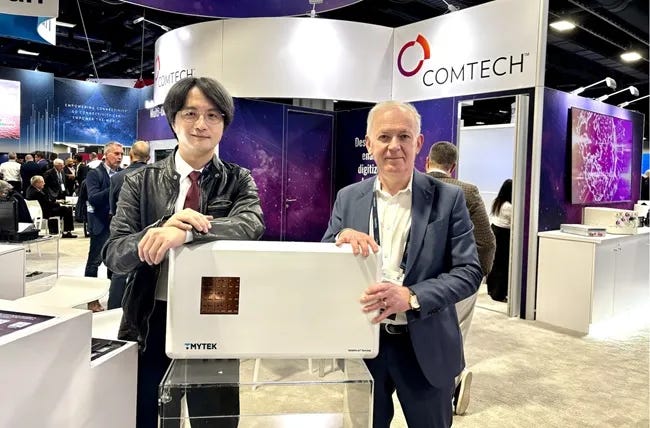Comtech Leverages Multi-Orbit Tech and Taiwan R&D to Reshape Communications Resilience Playbook for Asia-Pacific
As Taiwan braces for rising geopolitical risks, Comtech is quietly building the resilient satellite networks that could keep the island online—even if the undersea cables go dark.
In an era of heightened geopolitical concerns, Taiwan is aggressively seeking robust, alternative communication solutions to safeguard against potential disruptions to traditional infrastructure, such as vital undersea cables. Global satellite communications leader, Comtech, a 60-year-old, NASDAQ-listed company with annual revenues between $550 million and $600 million, is positioning itself as a key partner in this critical national effort.
The company is achieving this not only by providing resilient, multi-orbit technology but also by embedding itself directly within Taiwan’s dynamic and innovative R&D ecosystem.
Dr. Vagan Shakhgildian, President of Comtech Satellite Network Technologies Corp, outlined the company’s comprehensive strategy in a recent interview with TechSoda on the eve of the Asia Pacific Space Community Council (APSCC) Satellite Conference 2025, with the theme of “Sovereignty and AI”, held in Taipei for the first time. “At this point, the ecosystem is actually more important than the supply chain,” said Shakhgildian. “Our collaboration with TMYTEK is a prime example of us doing that.”
TMYTEK is an electronic scanning antenna (ESA) solution provider based in Taiwan.
At this year’s Satellite 2025 exhibition in Washington D.C., Comtech and TYMTEK unveiled a “Multi-Orbit Satellite Resilient Network Solution,” offering more efficient connectivity options for global mobile network operators (MNOs), enterprises, governments, and specialized applications.

Shakhgildian saw that Taiwan is very much a part of the vibrant Asia-Pacific region, which is undergoing an enormous transformation. “And that’s what gives us confidence that this innovative ecosystem that you’re developing in Taiwan is not just a blip…. Across the region, you have many customers that fuel the demand for technology innovation from emerging economies to established technology hubs as the digital acceleration across the region is truly reshaping industries, communities, and governments.”
He emphasized that Comtech brings decades of experience, expertise, and a successful track record in providing interference-resilient solutions to the US government and various allied governments—including the Taiwanese government—across the globe. This background provides a crucial foundation for addressing Taiwan’s unique resilience needs in the Asia-Pacific region.
The Multi-Orbit Answer to Blockade Fears
For Taiwan, the primary challenge for communication resilience is maintaining seamless connectivity even in the event of natural disasters or a potential geopolitical blockade that could sever its critical undersea fiber-optic links. As Dr. Shakhgildian acknowledges, while adversaries may seek to interfere with traditional communications, satellites themselves are not immune to jamming or bad actors. Therefore, he stresses that the ultimate and most resilient solution lies in the “plurality of solutions” offered by multi-orbit satellite capabilities.
Comtech’s modern approach provides inherent resilience by ensuring communication pathways can be dynamically switched across different satellite constellations:
Geostationary Earth Orbit (GEO): Traditional, high-altitude satellites providing wide coverage.
Medium Earth Orbit (MEO): Mid-altitude satellites offering lower latency and better throughput.
Low Earth Orbit (LEO): Newer, fast-moving satellites promising the lowest latency and highest bandwidth for demanding applications.
A cornerstone of this solution is Elevate 2.0, Comtech’s innovative, next-generation, cloud-native platform. This fully software-defined system is specifically designed to enable network operators and service providers to automatically and dynamically select the optimal connectivity path across GEO, MEO, or LEO, ensuring that communication flows freely and efficiently based on each application’s specific performance needs.
Furthermore, Comtech highlighted the resilience of its hardware. The company’s SLM-5650B modem, widely used by the U.S. and allied governments, is the first “sovereign” certified modem to operate on the SES O3b mPOWER constellation. This certification is critical, as it demonstrates that existing, proven hardware can be seamlessly adapted for multi-orbit connectivity, a key feature in modernizing ground segment equipment. Comtech’s expertise, Shakhgildian noted, is predominantly active in the ground segment—manufacturing equipment for Earth stations—but also extends to space-qualified components and intellectual property for signal processing units.
Collaboration Fuels Innovation Over Supply Chain
Comtech views its presence in Taiwan as more than just a business transaction; it is a collaborative R&D partnership. The company’s Canadian subsidiary, Comtech Satellite Network Technologies Corp, is actively engaged in a joint project with Taiwanese partner TMYTEK (TMY Technology Inc.) under the framework of the Eureka consortium, a Canada-Taiwan collaboration program that operates under the auspices of the European Union, the Canadian Space Agency, and others.
Eureka is the world’s largest intergovernmental network of countries supporting international research, development, and innovation. Founded in 1985 by 18 countries and the European Commission, Eureka has since grown beyond these geographic borders, spanning 47 countries, including Taiwan and Canada.
This high-level partnership is focused on developing state-of-the-art, software-defined SATCOM terminals. The long-term goal is to produce a super compact satellite terminal equipped with an electronically steerable antenna. This project leverages TMYTEK’s expertise in digital RF beamforming, a capability that extends beyond SATCOM and into advanced 5G cellular systems.
Shakhgildian emphasized that this focus on innovation is more important than the traditional hardware-oriented supply chain. He views this strategic collaboration as a prime example of Comtech engaging with Taiwan’s innovative core, rather than just its manufacturing capacity. The regional dynamism, driven by digital acceleration across the Asia-Pacific, provides the sustained demand that validates and fuels this innovation ecosystem.
Beyond 5G: The Path to 6G and Future Cooperation
Looking ahead, Comtech believes the convergence of satellite and terrestrial communications will deepen significantly with 6G technology. Shakhgildian points out that 5G already has a strong Non-Terrestrial Network (NTN) component, primarily composed of satellite connectivity. In 6G, the non-terrestrial component is expected to play an even bigger role, further cementing the strategic importance of satellite solutions for national connectivity.
The company confirms it is actively seeking new frameworks for collaboration and is currently in discussions with multiple major Taiwanese organizations with shared common values and geopolitical alignment between Canada and Taiwan.
By bringing decades of government-grade security expertise and cutting-edge multi-orbit platforms like Elevate 2.0, while simultaneously investing in Taiwanese R&D capabilities, Comtech is set to play an increasingly vital role in solidifying Taiwan’s standing as a highly resilient and connected technology hub.
This collaborative spirit, fueled by innovative technology, directly addresses the practical demand for reliable and flexible connectivity that is crucial to the island’s future.

